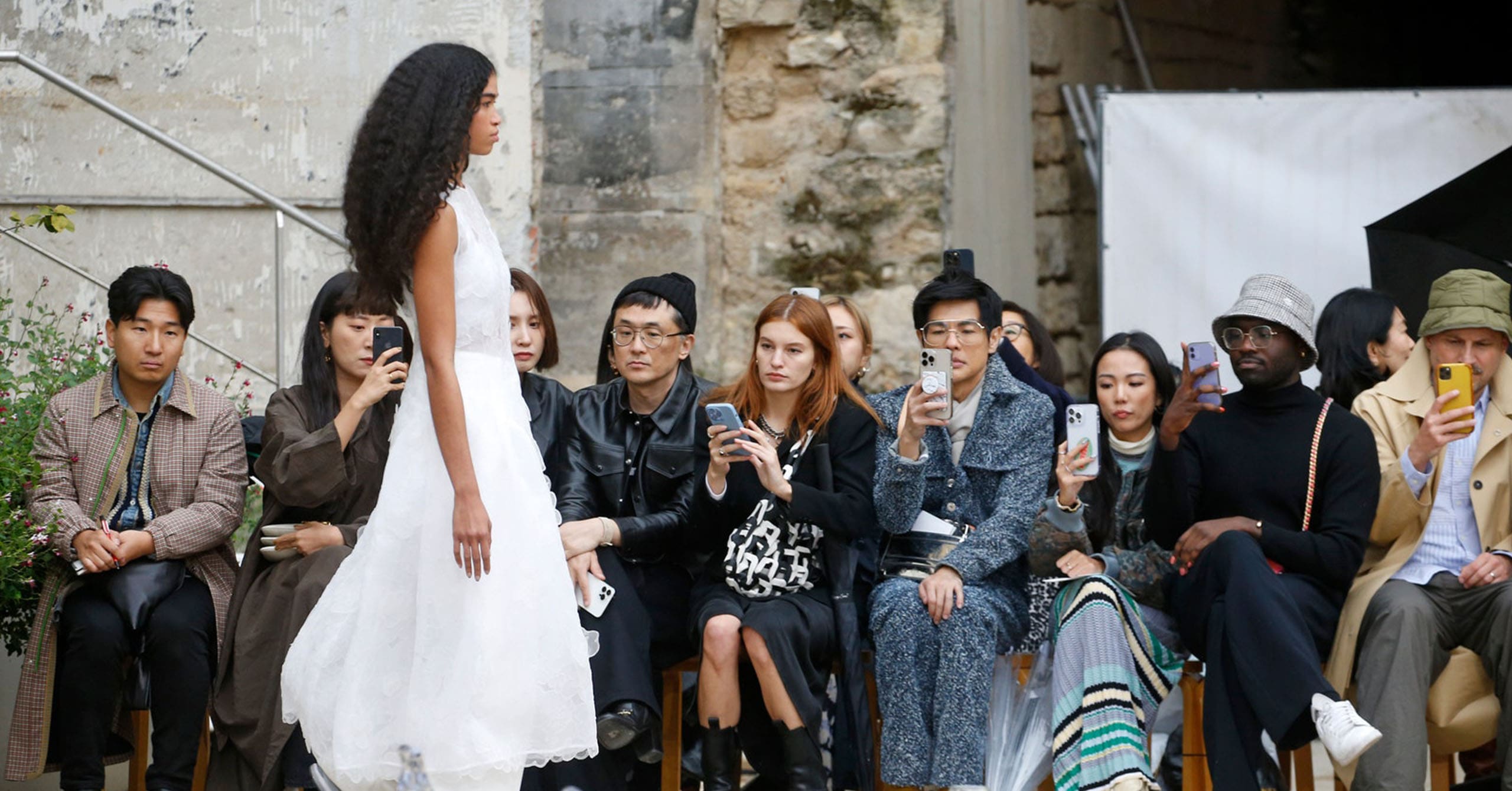Moon x Cecilie Bahnsen, spring 2023.
Photo: Thierry Chesnot / Getty Images
Moon x Cecilie Bahnsen, spring 2023.
Photo: Thierry Chesnot / Getty Images
Soft power is a term used in international relations to describe persuasive influence. According to Wikipedia, “it involves shaping the preferences of others through appeal and attraction.” It’s this kind of force that Martin Gjesing and Frederik Bjerregaard, the founders of the creative studio Moon, exercise from their home base in Copenhagen. Since its founding in 2013, the company has been a quiet mover in the industry, helping local brands such as Ganni and Cecilie Bahnsen cultivate cool and attain commercial success and global reach. Those brands’ ascendance and Moon’s run parallel to each other, and together they chart a rise of interest in the Scandinavian market.
Though their personal presentations vary—Bjerregaard prefers the professorial look of navy knits, denim, and baseball caps, while the tattooed Gjesing rocks black leather and cowboy boots—the two are aligned ideologically: “We’ll still refer back to the advice a football coach gave us, to the Gallagher brothers’ haircuts, and to what we watched on MTV’s Alternative Nation when we were teenagers,” says Bjerregaard. Likewise, the experiences they bring to Moon are complementary. Gjesing “was only 22 and wore cowboy boots on the outside of my jeans” when Acne Studios founder Jonny Johansson and CEO Mikael Schiller tapped him to be the CEO of the Swedish company’s Danish division. In the 10 years he was there the company’s overall annual turnover grew from €3 million to €150 million. Bjerregaard got his start in journalism, working on the sports desk at a Danish news agency. He credits his father’s entrepreneurial spirit with inspiring his own; “my upbringing might have something to do with me co-founding the Danish Fashion Institute, then later the Global Fashion Summit,” he said on a call. Bjerregaard also co-founded the jewelry company Sophie Bille Brahe.
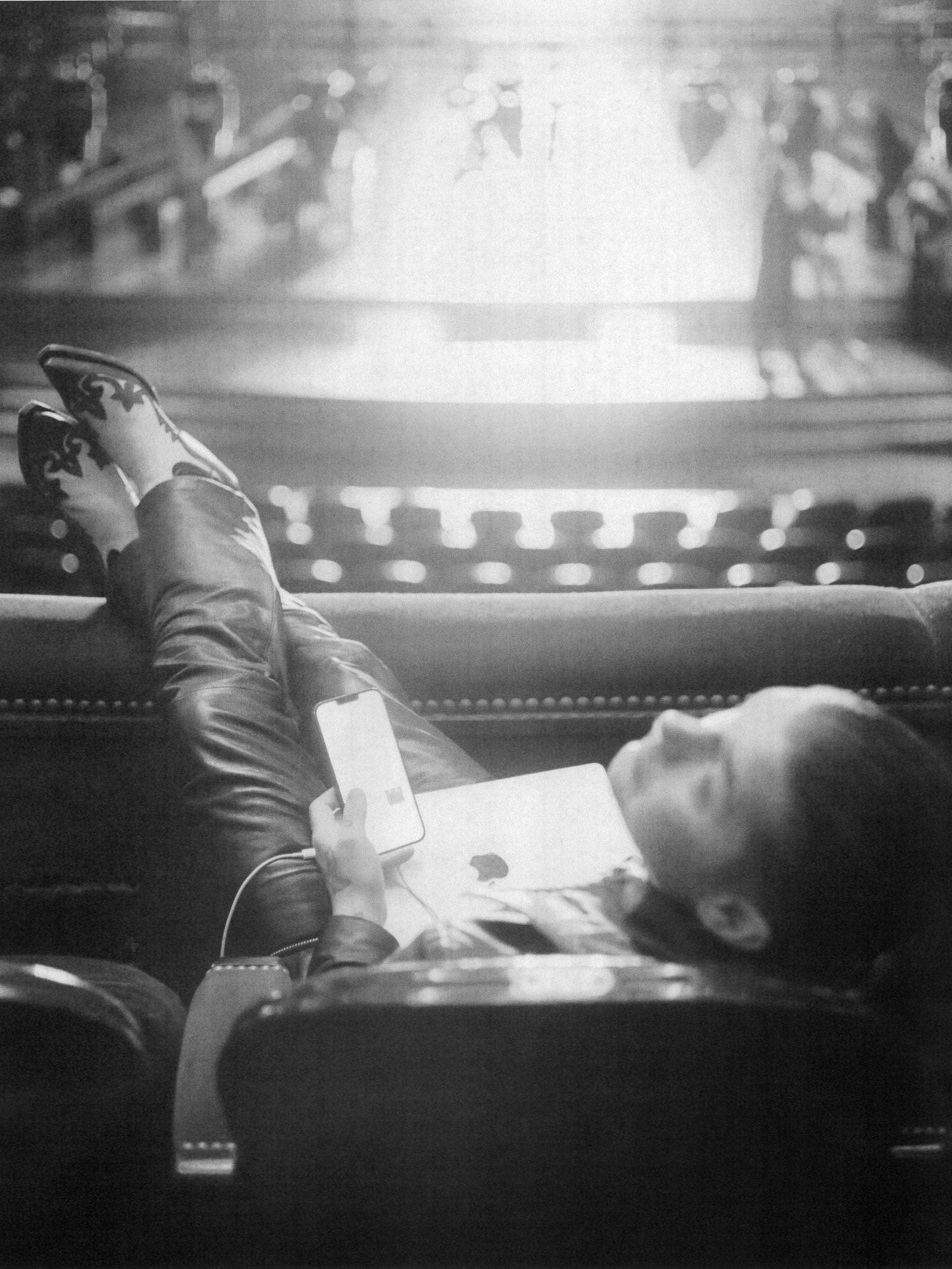

It was about the time that Gjesing, reviewing his phone bills (back when they were printed on paper), realized he was spending more time on the horn with Bjerregaard than with his wife, discussing their work and how they would do things differently, that the two decided to found Moon. “One of the things that became obvious through all of the conversations we had was that brands were either very good at doing business development/commercial strategies or great at being creative. But we felt that there was this blank space when connecting these two things,” Gjesing explains.
It was Antony and the Johnsons’ song “Future Feminism,” which is all about the power of earth’s satellite, that brought the name Moon into the business partners’ orbit. The round shape of our planetary orb seems to relate back to the team’s “360 mindset,” their “holistic” approach, and their desire to create “a closed circle; a universe,” but from a distance. The decision to remain in their hometown of Copenhagen gives Moon something of an “outsider” status. But staying local allows Bjerregaard and Gjesing to craft a healthy work/life balance. “The most important thing is that our office opens at nine in the morning and it closes at five,” says Bjerregaard. “We are a small company; we are always less than 10, and we try to do as good as we can with the things that we can control and make it personal; we are family oriented.”
To an outsider, this balanced approach feels especially Scandinavian, as does Moon’s preference for paring things back to the essential, which is only really possible once you have a thorough understanding of a subject. When Moon takes on a client, “we know that we’re going to start from scratch just like understanding how the people speak there, what they sell, what they dream about…. And when it comes to the output, trying to simplify what that’s all about in a sentence, in two sentences…” notes Bjerregaard. “I started out in journalism; I love a good wham, bam headline, simple and easy to grasp in an instant. For us strong words and images are the same: tricky to get right, easy to love. Good communication connects people, touches people.”
For Moon’s founders, success isn’t measured only by the bottom line. “It’s more like we created this universe that was meaningful to us,” Bjerregaard says. “One thing that is important for us is that moment where you get goosebumps… I think we both need to have that.”
What do you do?
Frederik Bjerregaard and Martin Gjesing: At Moon we put a lot of faith in our instincts when it comes to helping clients build the truest brands possible, authentic to themselves. We’re fascinated by the role fashion and culture play in the lives of people globally—and we want our work to speak to people’s instincts and emotions. So, we are investigative and intuitive by nature, there is always a sense of what “feels” good, right for now, whether that’s helping Cecilie Bahnsen turn her signature silhouette into a global fashion cult, or introducing a fashion sensibility into Magniberg’s world of bedwear and interior products. On the other hand, we are very precise and data-driven when it comes to branding strategy and execution. I think having a “hustle” energy helps too.
Scaling a brand without selling out is always a challenge—holding dear to your integrity and not letting go of what you believe in. Working with Ganni we managed it, helping Nicolaj and Ditte make their brand instantly familiar to a global audience. Today Ganni represents so much more than fashion. It stands for Copenhagen, for Scandi-style and the idea of the “Ganni girls” community. It’s also a brand whose values and sense of responsibility have deepened and increased as it’s grown. The statistics speak for themselves. The Ganni spring 2023 show in August [Editor’s Note: produced by Moon] was a global hit: more than 1.2 million views on YouTube; 12.6 million impressions across social channels in China; 50+ articles in leading publications; 1000+ stories and mentions on Instagram and TikTok. All of it underpinning the fact that Ganni is a global phenomenon.
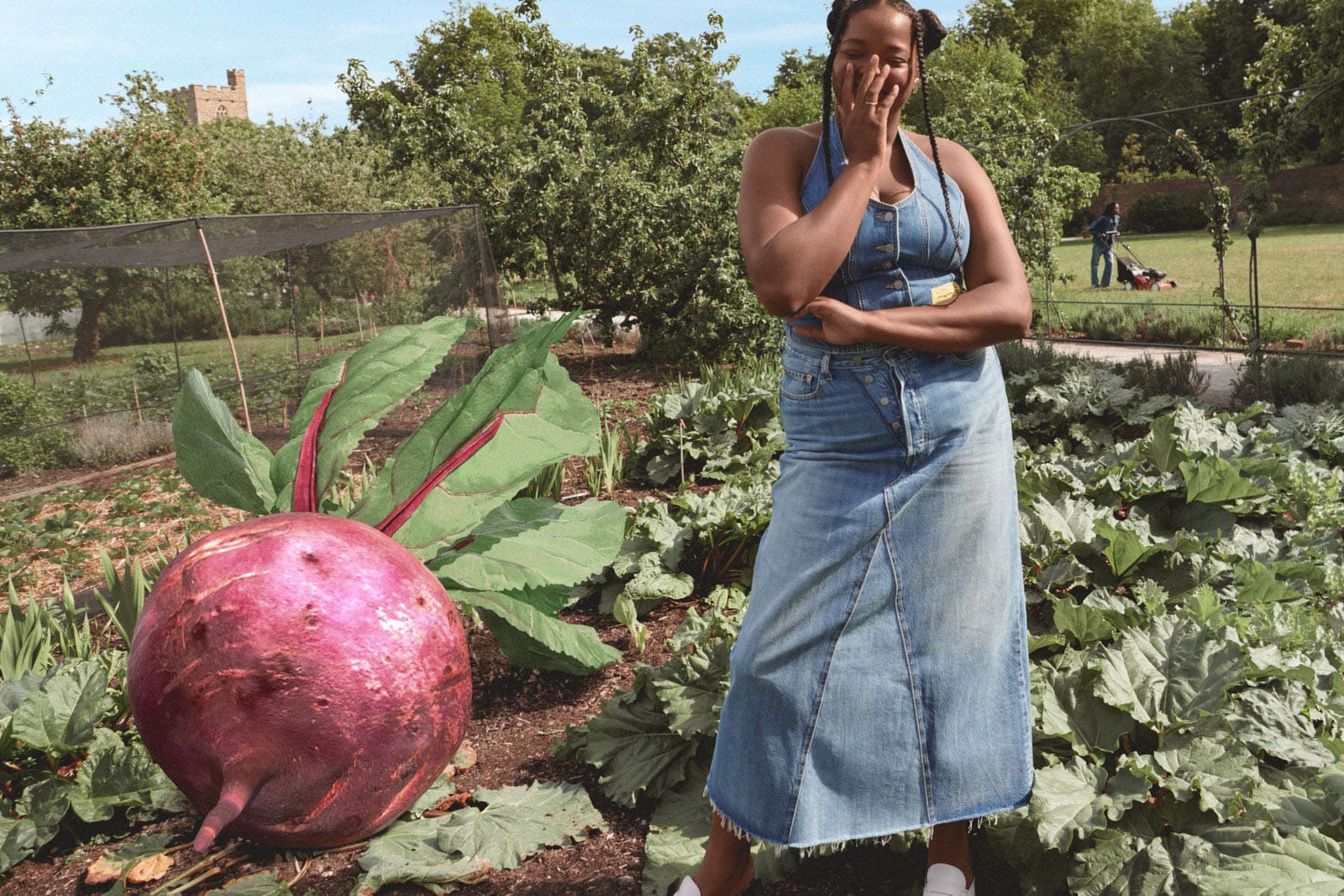
What’s your involvement with Copenhagen Fashion Week?
FB & MG: On one hand CPHFW is business as usual. Even busier than usual, actually. It’s a fun week for Moon. We’ve been prepping for months. Now it’s showtime. But Fashion Week also means we get to spend time with our friends and collaborators. We’ve always worked with friends or people we like, or connect with—it’s one of our golden rules—so Fashion Week is a lot of fun, too.
Monday is Cecilie Bahnsen, a super-intimate “bedroom dream pop” concert with the French singer Suki. Cecilie is one of our longest collaborators and oldest friends. We just did a launch for her Asics collab in Paris, and we’re working on her upcoming Paris show, so this is a nice relaxed in-between moment. Tuesday is the Sunflower show. These guys are our downstairs neighbors in the office, and really good friends. The show is in our communal courtyard and we’re keeping it low-key simple, but expect an ’80s surprise. Wednesday is Little Italy, which is this project we’re doing with the Danish swimwear icon, H2O. We’ve been working with them on a Sicilian summer campaign, and this is the opening, launching a capsule collection and temporary Palermo shop in the center of Copenhagen. Later in the night we’re cooking up pasta vongole with the Italian footwear company Diemme at Martin’s Italo Caffé. Thursday is massive. It’s the Ganni show, which is always special to us. We’ve worked with Ditte and Nicolaj Reffstrup since the beginning, when they had a handful of staff, and we were just four on the team at Moon. This season is super exciting, a tech heavy show that taps into the DNA of the Ganni girl.
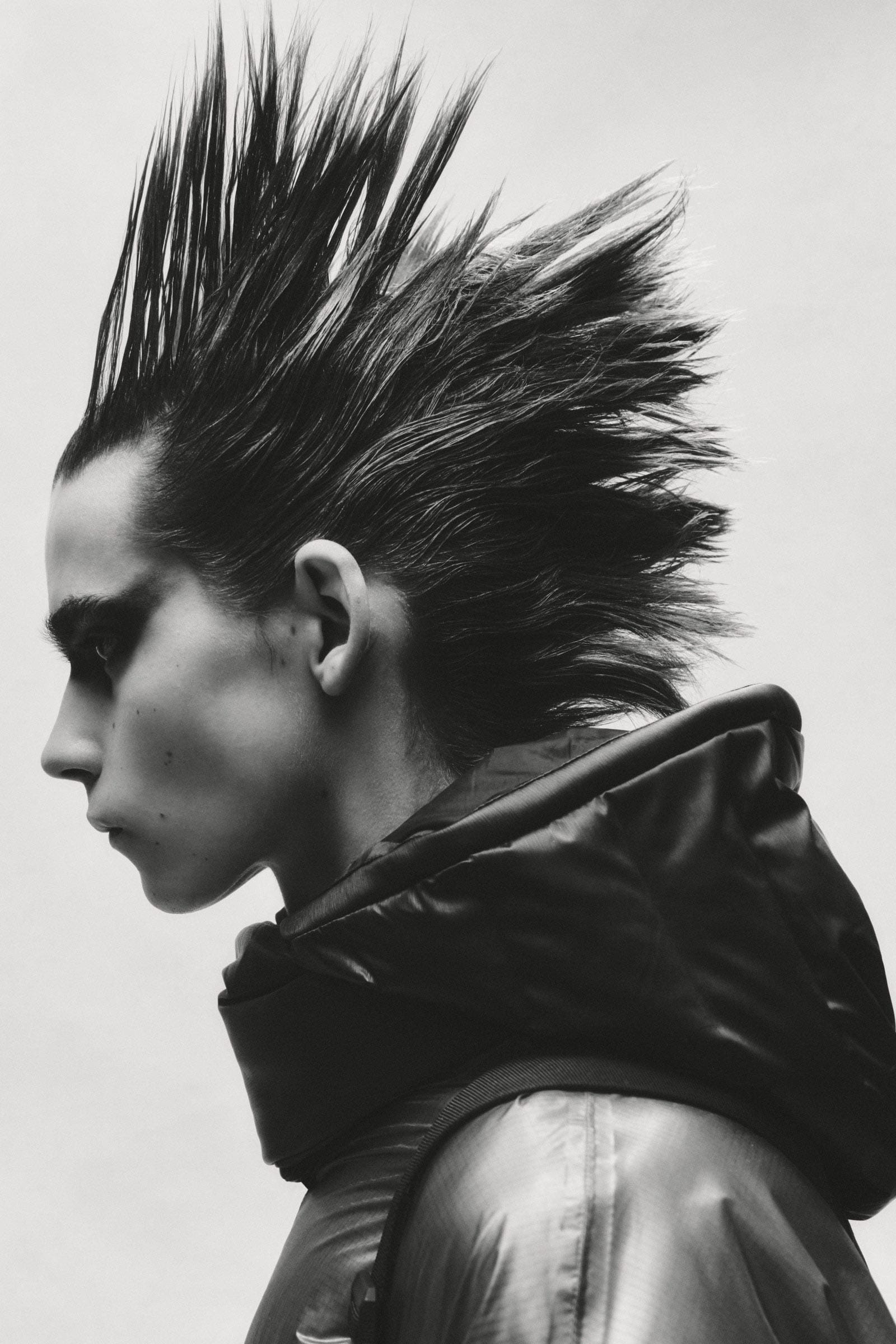
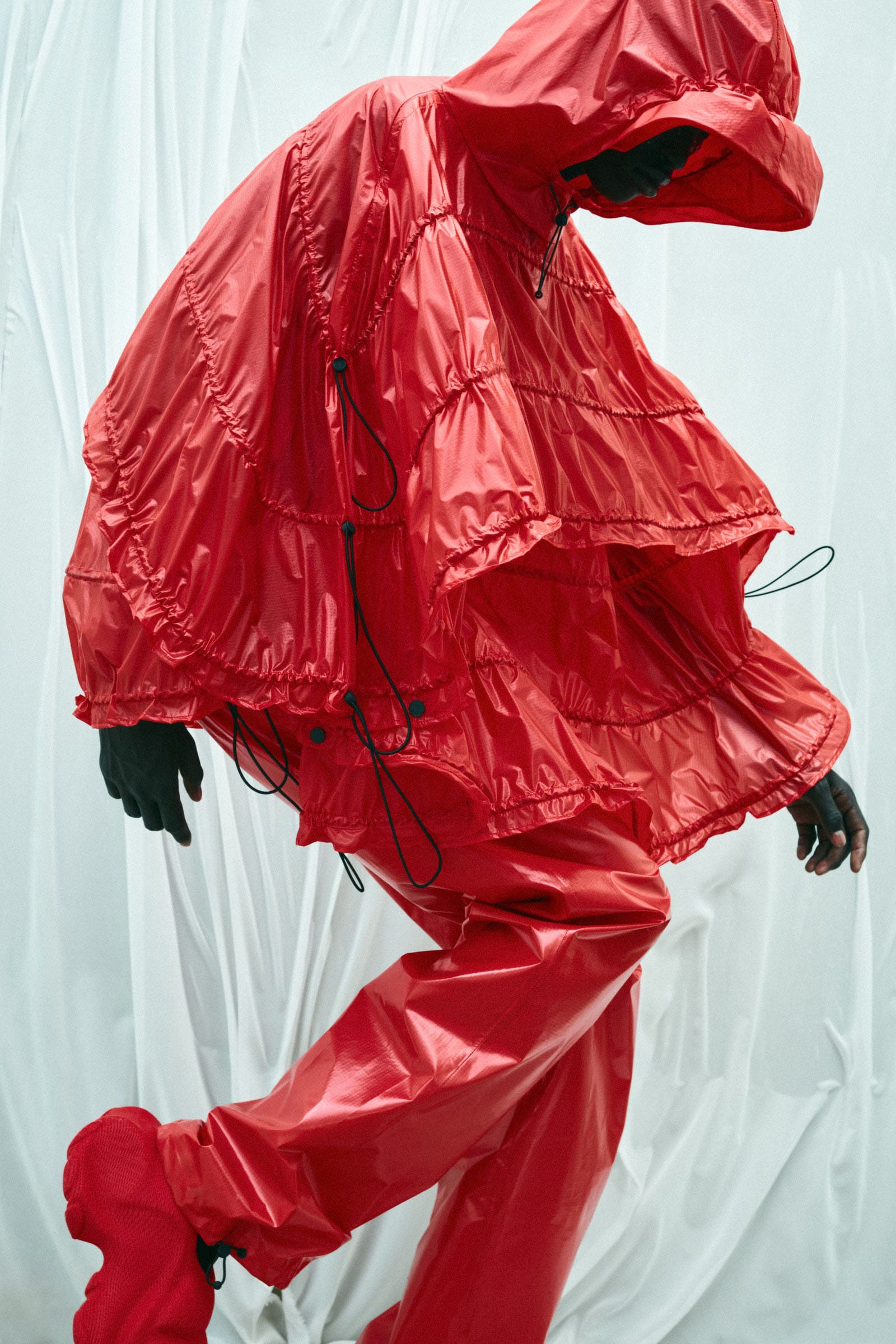
Where do you see the week going? How, if at all, could it be an even more essential part of global fashion?
FB & MG: CPHFW and a few amazing brands have managed to create an atmosphere that means people come to Copenhagen from everywhere. Fashion people are always telling us how they now they start their traditional August holiday a little later to squeeze in CPHFW. It’s become an important part of their calendar. Partly that’s the focus on how to do a fashion week more sustainably—that has inspired the industry globally. August is also the best time of year to visit Copenhagen, take a dip in the harbor. What’s not to like?
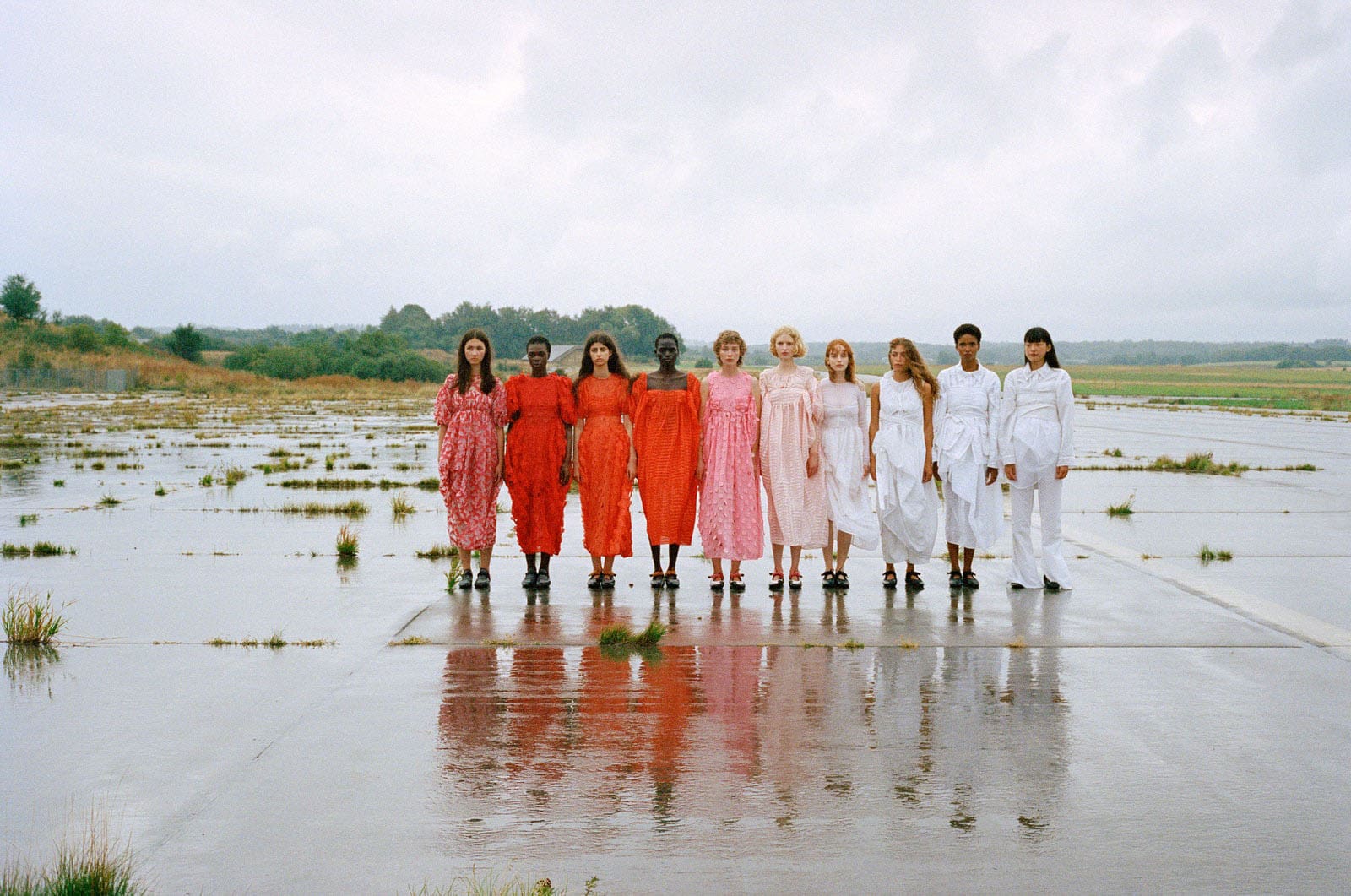
What’s the secret of the Scandi way?
FB & MG: We honestly don’t think there is a secret to the Scandinavian sense of style. Partly how Scandinavian women dress is about lifestyle. Everyone knows about Copenhagen girls getting everywhere on their bikes. At the beginning of Ganni that really was a big thing for Ditte, designing clothes that worked for herself and the women she saw around her on the streets, who didn’t want Scandi minimalism. Sneakers and dresses. We often talk about this idea of “not saving for best.” You wear your most favorite dress to work on a Tuesday morning to feel good and super nice. It’s a very Copenhagen mindset—the best for everyday.
Looking at the bigger picture, we know how we felt at Moon starting out. It was the feeling of being outsiders in fashion—we weren’t in London or Paris. I know that Ganni felt that too, Bengt Thornefors from Magniberg as well. It makes us work super hard, and maybe we have an edge because of it. I think also, we grow up surrounded by nature in Scandinavia so the idea of being responsible for the planet is wired in, so we had that realization earlier, of needing to care for nature.
What are the qualities that make you want to work with someone?
FB: Good or bad taste doesn’t exist in our world. A collaborator needs to have a personal take, a real point of view: whether it’s a photographer like Rosie Marks or Casper Sejersen; a musician like Dev Hynes, or a designer like Ganni’s Ditte Reffstrup or Grace Wales Bonner. It’s super inspiring to work with someone who has the vision and drive to push their own thing through. That’s exciting whether it’s a client or a creative partner. Honesty and loads of energy are also good.
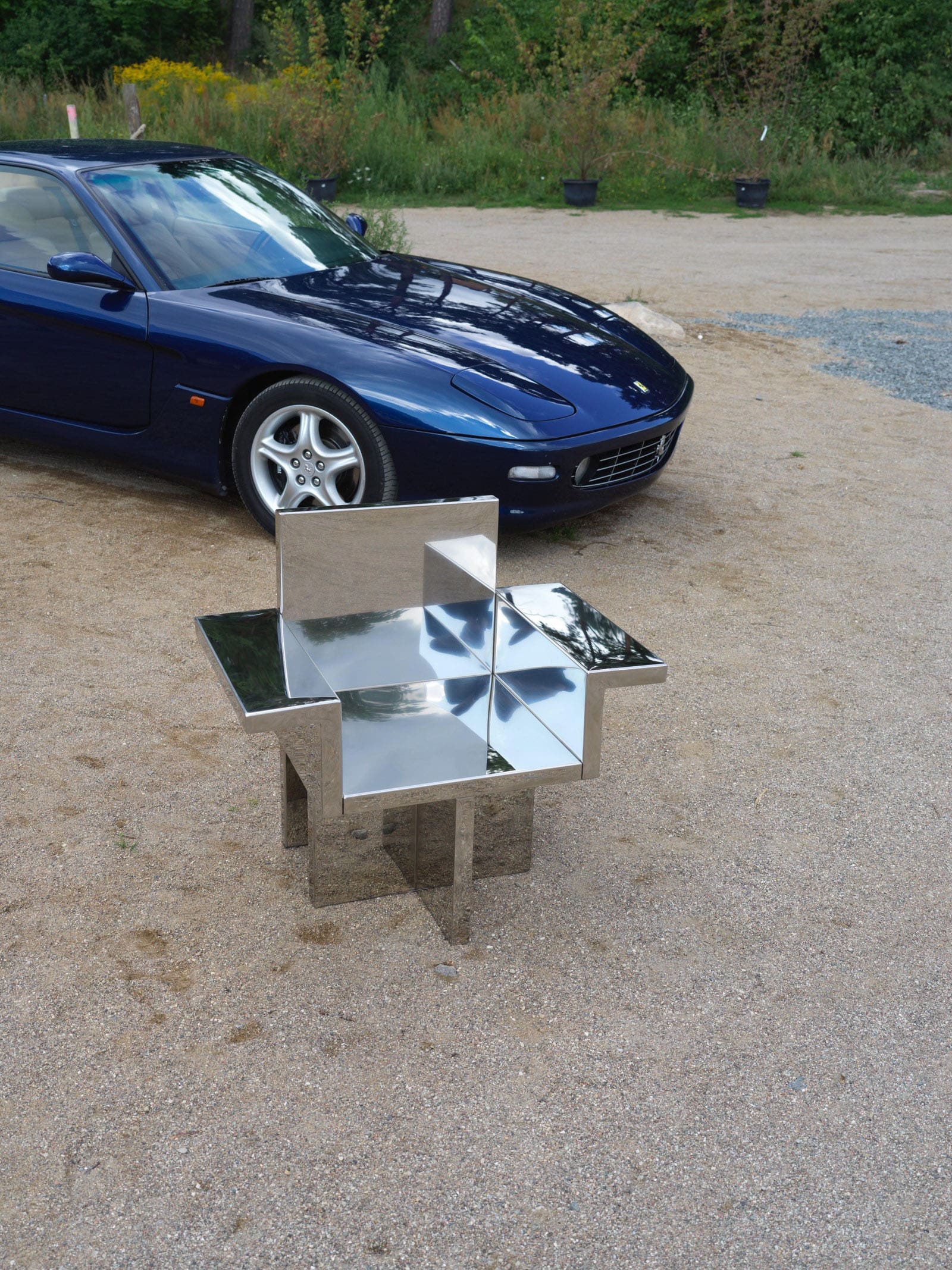
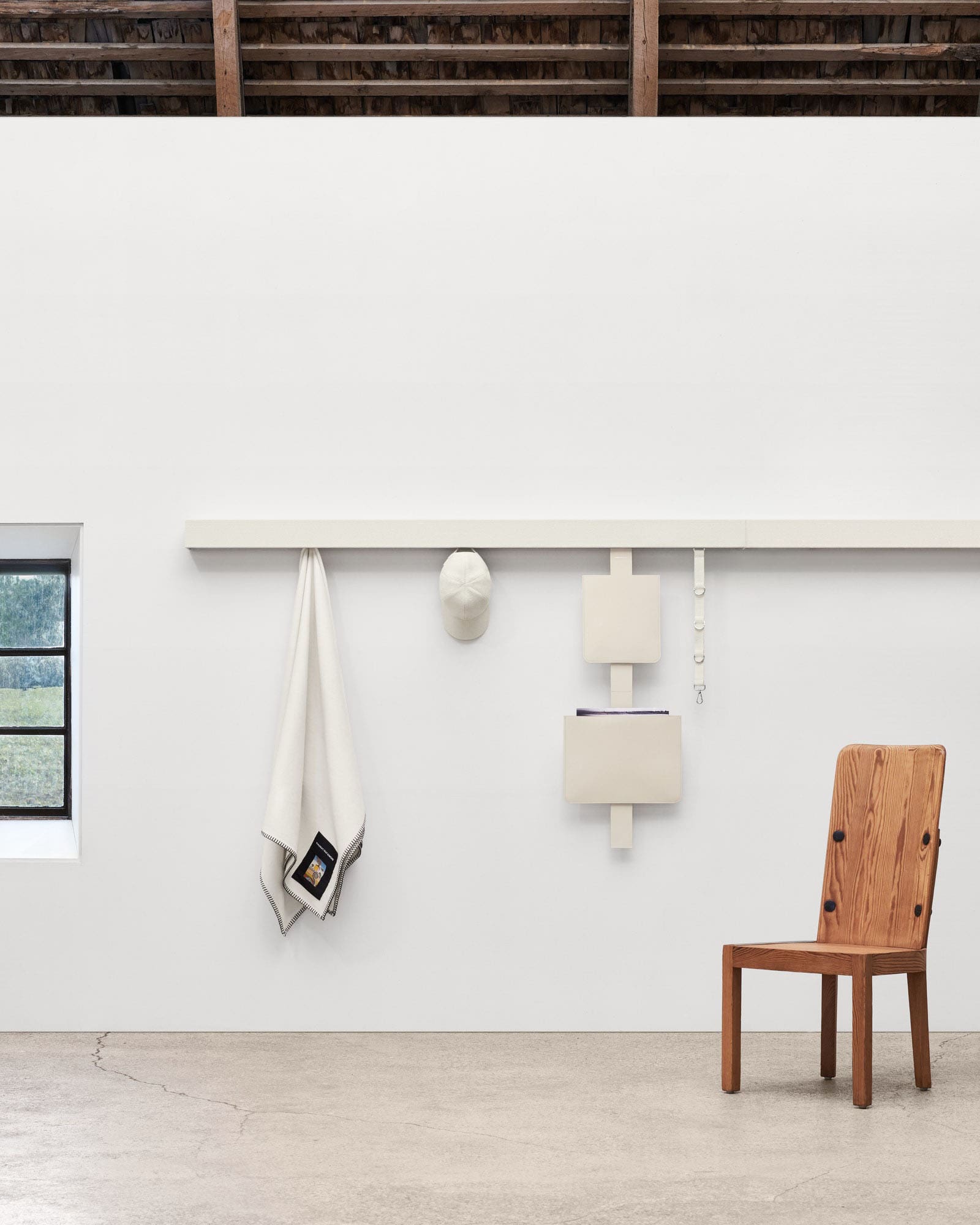
What are the benefits and dangers of working with friends?
MG: We’ve never separated work from our personal lives. For better or worse, we let it intertwine. Our partners work with us at Moon. My wife is our studio manager and our 16-year-old daughter pops into the office after school. Frederik’s four-year-old is with us at the shows in Paris. His wife Emelie is a creative director who is part of the team. She has styled Ganni since year dot.

How has the fashion world changed in the 10 years of Moon?
MG: From our perspective brands got more thoughtful, much smarter and a whole lot faster the past decade. Among the brands and people we work with, the overall capacity has skyrocketed, and if we look towards friends like Ester Manas, Grace Wales Bonner, or Our Legacy it’s insane how good they have become over the years. Unfortunately, it feels like the fast pace makes other people forget to listen to both their heart and brain. It’s often easy to see what decision would be right, both strategically and ethically, but because of the high speed, brands compromise in negative ways. But to stay on a positive note, Grace Wales Bonner is incredible. Her first show in Paris this January demonstrated how much has changed in the industry the last 10 years.
Are you hopeful for the future? What do you want to see change in the industry?
MG: It’s a crazy world we live in, but we don’t fear change, we believe in renewal as opportunity—and we work with clients to face their fears and anxieties about change. We try to think like a brand, always. I still go and visit stores in each city I visit, to keep wired into the commercial state of the business. This ensures that we are in tune with the challenges and possibilities our clients face. We want to be ahead of what they see, proactively developing concepts and strategies before they might know they need it.
Who would your dream clients be?
FB: We already have our dream clients. Still, we would love to take a business with a radical approach to sustainability and help make it a gigantic success. Whether that’s a 17-year-old fashion wonderkid, or Nike inviting us to join a change like that, we are ready to rumble.
This interview has been edited and condensed for clarity.
This article was originally published on Vogue.com
- 5 Things To Know About The Fabulous, Fetish-Inspired Alaïa SS24 Show
- Ciane Xavier Is The Pop Surrealist Making Wearable Art
- Fashion’s Mid-Term Report: Are We Reaching Our Sustainability Goals?
- “It’s Couture, But It’s Also Reality”—A Conversation Between Jean Paul Gaultier and His New Guest Designer Julien Dossena
